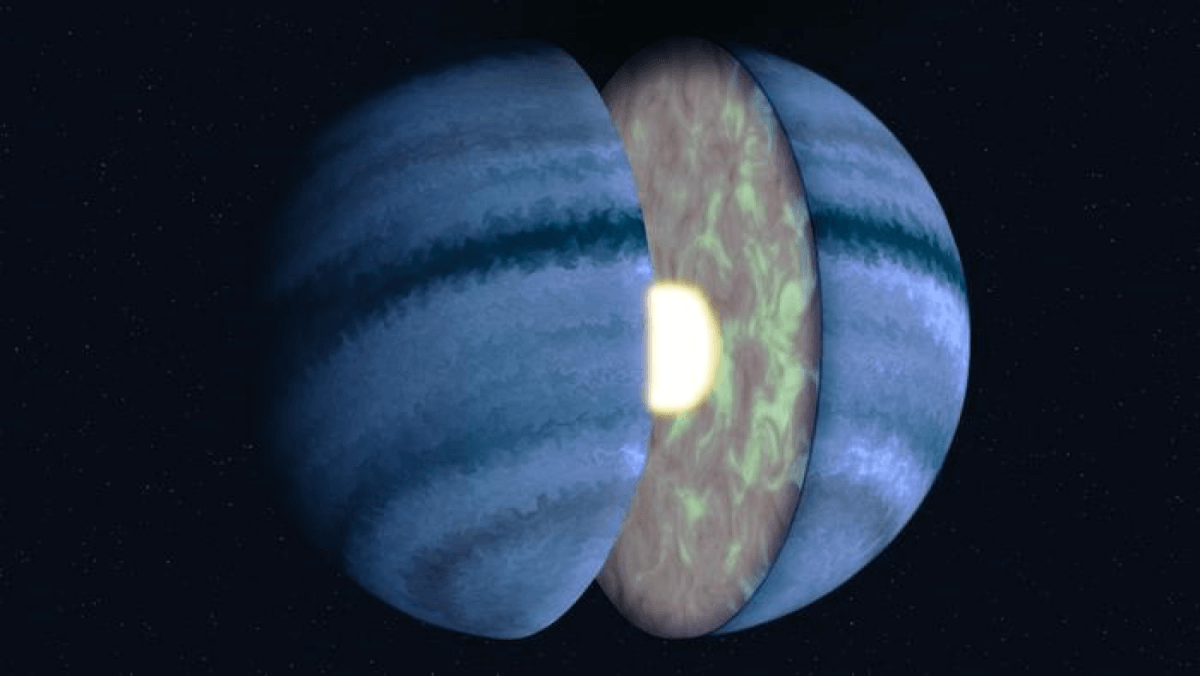
An artist’s concept of WASP-107 b shows turbulent atmospheric mixing within the planet’s gas envelope. (CREDIT: Roberto Molar Candanosa/Johns Hopkins University)
BALTIMORE — Humans are getting their first glimpse at the inside of an alien world out in deep space, thanks to the James Webb Space Telescope. If you could travel hundreds of light-years from Earth to the cotton candy-like planet WASP-107b, you'd find a puffy, Jupiter-sized world wrapped in a scorching atmosphere. Despite its extreme heat and vastly different makeup than Earth, astronomers believe this distant planet may hold important clues about the late stages of planetary evolution in our universe.
Using the powerful Webb Telescope, astronomers have made the first-ever measurements of an exoplanet's core mass and atmospheric composition. Specifically, they pointed the advanced space probe's telescope at the interior and upper atmosphere of WASP-107b, located around 200 light-years away from Earth.
For starters, the planet contains a stunningly low amount of methane, one of the main components making up the atmospheres of gas giants like Jupiter and Saturn in our solar system. Methane is also a key building block for life here on Earth.
“We want to look at planets more similar to the gas giants in our own solar system, which have a lot of methane in their atmospheres,” says lead author David Sing, a Bloomberg Distinguished Professor of Earth and Planetary Sciences at Johns Hopkins University, in a media release. “This is where the story of WASP-107 b got really interesting, because we didn't know why the methane levels were so low.”
So, what's going on within this distant world? Publishing their work in the journal Nature, the astronomers think the methane on WASP-107b is transforming into other compounds like carbon dioxide and carbon monoxide as it flows up from the planet's interior. In the upper atmosphere, it interacts with other chemicals and the intense starlight from the planet's parent star, causing chemical reactions that destroy methane.
“We had never been able to study this mixing process in an exoplanet atmosphere in detail, so this will go a long way in understanding how these dynamic chemical reactions operate,” Sing continues.

Understanding atmospheric chemistry will be especially important as scientists start looking at smaller, rocky exoplanets for potential signs of life, or “biosignatures.”
The researchers made another startling discovery about WASP-107b's interior composition. Despite the planet being only about one-tenth the mass of Jupiter, it contains a solid core around 12 times more massive than Earth's!
“The planet has a hot core, and that heat source is changing the chemistry of the gases deeper down, but it's also driving this strong, convective mixing bubbling up from the interior,” explains Zafar Rustamkulov, a doctoral student who co-led the research.
In other words, the intense heat from the planet's massive core causes the gases to churn and mix vigorously, transporting the altered atmospheric chemistry upward from the interior. This provides a rare glimpse into the connection between the deep interior of an exoplanet and its outer atmosphere.
The planet's puffy, expanded atmosphere is likely inflated by the residual heat still radiating from this oversized core left over from its formation.
“We think this heat is causing the chemistry of the gases to change, specifically destroying methane and making elevated amounts of carbon dioxide and carbon monoxide,” adds Rustamkulov.
So, while WASP-107b is definitely not a candidate for life as we know it due to its extreme heat and lack of a solid surface, studying its unique atmospheric chemistry and interior could shed light on the evolution of planets in general.
“It's something we definitely need as we start looking at rocky planets and biomarker signatures.” Sing says, referring to potential signs of life detectable in atmospheres.
The Johns Hopkins team now plans to use Webb to study 25 more exoplanets and test theories about what's keeping WASP-107b's core so intensely hot over time. Just like the gravitational pulls causing tides on Earth, perhaps the planet is being stretched and contorted by the gravitational forces of its parent star.
While WASP-107b may look like a delicate ball of cotton candy from hundreds of light-years away, this “fluffy” world is providing a rare insider's view into the unique processes driving atmospheric chemistry and planetary evolution around other stars. For astronomers, that's the ultimate candy-coated scientific treat.
EdNews Editor Chris Melore contributed to this report.










